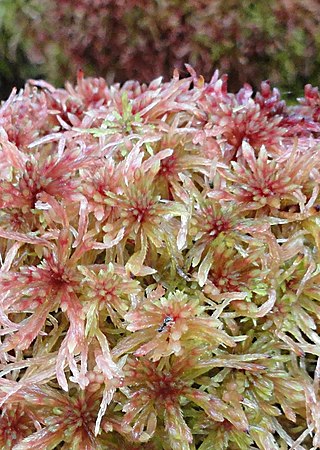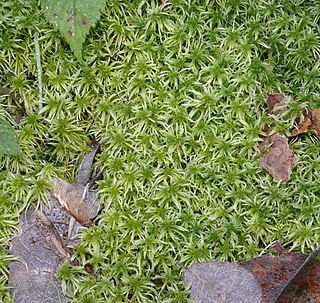
Riccia fluitans, the floating crystalwort, is an aquatic floating plant of the liverwort genus Riccia which is popular among aquarists as a retreat for young fry and is used in live-bearing tanks. It can be found floating in ponds, and often forms thick mats on and under the water surface.

Bryology is the branch of botany concerned with the scientific study of bryophytes. Bryologists are people who have an active interest in observing, recording, classifying or researching bryophytes. The field is often studied along with lichenology due to the similar appearance and ecological niche of the two organisms, even though bryophytes and lichens are not classified in the same kingdom.
Sphagnum affine, the imbricate bogmoss, is a species of peat moss or sphagnum moss which is exploited to make commercial peat products. This moss has a yellowish coloring.
Bryum warneum, known as sea bryum or Warne's threadmoss, is a protected moss found in sandy coastal areas in temperate regions of Europe and is also recorded to have been found in the Himalaya, the Altai Mountains and in Quebec, Canada.

Discelium is the only genus of moss in the family Disceliaceae; it contains the single species Discelium nudum, the flag-moss. This species is rare, but is widely distributed in cool and temperate climates of the Northern Hemisphere.
Pohlia scotica, commonly known as Scottish threadmoss, is a moss endemic to Scotland. The earliest records date to 1964 and this moss was recognised as a distinct species in 1982. The largest populations are in Argyll with smaller populations in Dunbartonshire and Easter Ross. Its favoured habitat is silt, sand and gravel subject to regular inundation. The species has been provisionally classified as Lower Risk and receives protection under the Wildlife and Countryside Act 1981.

Hylocomium splendens, commonly known as glittering woodmoss, splendid feather moss, stairstep moss, and mountain fern moss, is a perennial clonal moss with a widespread distribution in Northern Hemisphere boreal forests. It is commonly found in Europe, Russia, Alaska and Canada, where it is often the most abundant moss species. It also grows in the Arctic tundra and further south at higher elevations in, for example, northern California, western Sichuan, East Africa, Australia, New Zealand and the West Indies. In Scotland it is a characteristic species of the Caledonian Forest. Under the UK's national vegetation classification system, pinewood community W18 is named as "Pinus sylvestris-Hylocomium splendens woodland", indicating its significance in this ecosystem.
Bryum dixonii, commonly known as Dixon's threadmoss, is a moss endemic to Scotland. The species occupies montane habitats, and although rare it has a wide distribution including the central and north-west Highlands, and the islands of Skye, Rùm and St Kilda. Originally discovered on Ben Narnain, Argyll, in 1898 by Hugh N. Dixon, it was not seen again until 1964 when found by Ursula Duncan at Juanjorge in Glen Clova in Angus. As of 2000 there was no species action plan for its protection.
Didymodon mamillosus, commonly known as Perthshire beardmoss, is a species of moss endemic to Europe. It occurs at only five sites including one in Scotland where it is classified as "Critically Endangered". The other sites are in Iceland, Germany, the Czech Republic and in north-east Spain.

Sphagnum angustifolium, the fine bogmoss, is a species of peat moss with a Holarctic distribution.

Sphagnum russowii, Russow's sphagnum or Russow's bogmoss, is a species of peat moss with a Holarctic distribution.

Sphagnum girgensohnii, also known as Girgensohn's bogmoss, Girgensohn's sphagnum or common green peat moss, is a species of peat moss with a Holarctic and Indo-Malesian distribution.

Pellia epiphylla is a species of thallose liverwort. It occurs in North America, Europe, North Africa and parts of Asia. It grows in patches in damp, sheltered places on neutral or acidic substrates. It is common on the banks of rivers, streams and ditches and also grows in wet woodland, marshes and on wet rocks.

Zygodon gracilis, the slender yokemoss, is a moss species in the genus Zygodon. It is a rare lithophyte found to only grow on certain localities of limestone outcrops that has high calcium carbonate content. The current global conservation status of Z. gracilis is considered to be "imperiled".
The British Bryological Society is an academic society dedicated to bryology, which encourages the study of bryophytes. It publishes the peer-reviewed Journal of Bryology.
Edwin Bunting Bartram was an American botanist and bryologist. He described many dozens of new species in bryology, and contributed 143 works, including a number of books. He was a member of the Academy of Natural Sciences, Philadelphia Botanical Club, Torrey Botanical Club, New England Botanical Club, Sullivant Moss Society and British Bryological Society.

Sphagnum fimbriatum, the fringed bogmoss, is a slender Sphagnum moss.

Rhizomnium punctatum, also called dotted thyme-moss, is a small species in the genus Rhizomnium.

Alexander William Evans was a botanist, bryologist, and mycologist that specialized in the flora of Connecticut.
Eleanora Armitage was a British bryologist who was a founding member of the Moss Exchange Club, the British Ecological Society and the British Bryological Society and served as president of the later organisation in 1939. She was an accomplished collector and her herbarium is now held at Bristol Museum. She was also a member of the British Association for the Advancement of Science as well as the Royal Horticultural Society.











